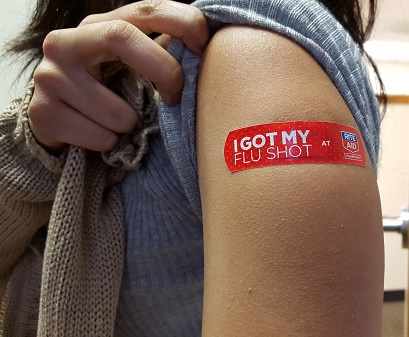Flu Virus Unpredictability Becomes Problematic

October 6, 2016
Last flu season, the overall effectiveness of the flu vaccine was 47%, meaning that of the people who got the flu vaccine, 47% of them didn’t exhibit any flu symptoms. Though that may not seem like a high success rate, the percentage doesn’t include partial protection against influenza (flu) from getting the flu vaccine.
The flu vaccine is a difficult vaccine to create because of the unpredictability of the flu virus itself. There are many different strains of influenza, and they continuously change — so the scientists creating the vaccine will have to try to stay one step ahead. Scientists use data from previous flu seasons around the world and work in a lab to create the best defense against the flu strains that will most likely circulate this flu season. The difficulty is predicting it accurately. Some years the strains of influenza virus in the community are not the strains predicted, therefore the vaccine will create antibodies that will be less effective against the virus. Even though the vaccination may not protect against the exact strain of influenza, it may still provide some protection.
“There is that claim — ” Ms. Chavez-Riley, the school nurse, said. “And I believe it to be true from my experience — that when kids get the flu, and it’s not the particular strain of flu that was in the shot, the shot still gives them a certain amount of protection with the different antibodies you develop from the shot. So that you’re protected somewhat from the flu without having the [right] shot. In other words, you can get [the flu] still, but it won’t be as bad and as damaging to you and keep you home as much as if you didn’t have the shot.”
Though the flu may be considered a “seasonal cold” by many, influenza typically feels much worse than that, especially if you haven’t been immunized. In 2014, the flu vaccines were not matched well to the flu viruses that were most common. Before 2014, the influenza strain H1N1 was the most common strain, so the vaccination mostly immunized against that strain. However, a different strain, H3N2, became more prevalent that year, making the vaccine less effective. A report released in 2014 showed that influenza and pneumonia was the eighth leading cause of death in the United States with 55,227 deaths. Since then, the mortality rate has lowered sufficiently, since the vaccinations have been better matched to the flu strains of these last few seasons.
“I think every year they just go by what’s out there now,” Ms. Chavez-Riley said. “And you’d think we could have a magic ball that could just say, ‘OK, this particular ABC influenza is going to affect us this year,’ but they just don’t. They go by histories of different flus that have been out, and they go by what’s currently in the environment, and they do the best they can with how they can do it. And you know, like I say, it’s man made, but I get the shot every year and I haven’t had the flu in 10 years so it does affect some of us. Some of us may build up resistance, but it is the best shot we have in an imperfect world.”
When a sufficient percentage of a population is immunized against influenza, it makes the spread of flu less likely from person to person, even for those who have not been immunized. This is called herd immunity, and it is especially beneficial for those who are not able to get their vaccination because they are younger than six months or allergic to the vaccine. Also, if someone’s immune system is suppressed due to medications or existing medical conditions, they will not mount an adequate response.
Since 2003, there have been many different options for vaccines against the flu, including trivalent vaccine shots (which immunizes against three different strains of influenza) and quadrivalent vaccine shots (which immunizes against four strains of influenza). There is also FluMist, a live vaccine which was delivered nasally. Last flu season, however, FluMist showed to have little-to-no effectiveness in preventing the flu in its recipients. So this year, the CDC recommends not getting the FluMist. Scientists are not sure why the FluMist wasn’t effective last flu season. In previous years, the FluMist had actually been more effective than the shot.
For more information about influenza and influenza vaccinations, visit https://www.cdc.gov/flu/. If you want to get the vaccine, you can contact your doctor and make an appointment or go to your local CVS Pharmacy, Walgreens, or HEB Rediclinic. The flu vaccine is available and now is as good a time as any to get vaccinated.


